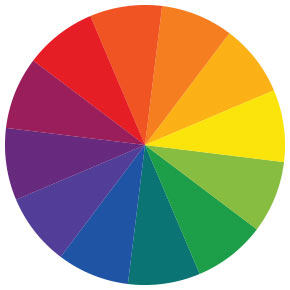Creating a Colorful Landscape
Using Color Theory in Landscape Design
Color is one of the most exciting aspects of any garden. Your garden may bloom in every color of the rainbow or just one or two. But before you start mixing colors, let's review the basics of color theory. Colors give us a feeling or perception of either warmth or coolness. Cool colors are shades of blue and violet. Warm colors are shades of red, yellow and orange. Warm colors are perceived as advancing while the cool colors seem to recede. Cool colored flowers will recede even more if they are placed in the shade.
The perception created by warm or cool colors can be used in planning your flower beds. When planted at a distance, warm colored flowers will appear closer while cool colored flowers will appear farther away. A planting of cool-colored flowers at the rear of the yard will make the yard seem larger. Warm colored flowers planted in the rear of the yard will make the yard seem smaller. Plant cool-colored flowers closest to the point from which they will be viewed since cool colors are best viewed up close. Cool colored flowers are very effective near a patio or next to a sidewalk. Warm colored flowers are effective in bringing a distant part of the yard into focus. Warm colors will create a dramatic display in any yard or garden and will draw attention to the landscape. Neutral colors include browns, grays and greens.
Monochromatic Landscaping with Color
A monochromatic garden has only one color. This can be achieved by using different shades of the same color in a garden bed or landscape. We offer flowers in all the colors of the rainbow: red, orange, yellow, purple, even pink and white. Use our Plant Finder to filter by flower color.
Incorporating Different Colors Together
You can also use the color wheel below to determine what colors to use in your landscape and garden. One easy way to combine colors is to use analogous colors, which are next to each other on the color wheel. Analogous colors tend to blend together well.

Another way to combine colors is using complementary colors, which are opposite each other on the color wheel. Complementary-colored flowers can add a lot of pop to your garden and landscape. Try mixing perennials with bulbs to really spice up your landscape. Try yellow daffodils with green hostas or purple alliums mixed with daylilies and irises.
Experiment with colors by cutting a few pictures out of garden catalogs and rearranging them. To help tie different sections together, repeat a few colors throughout the garden. Try cool colors with a few sparks of warm colors, or warm colors with a few cool colors.
Multicolored flowers, such as the Double Jill Dahlia, Flaming Flag Tulip, Princess Margareth Rose Gladiolus and Empoli Lily, can also give you a few clues about mixing colors. After all, who knows better than Mother Nature?
Whatever color scheme you decide upon, it's important to plant in masses of color. In other words, plant each flower in groups of at least three to twelve flowers. Otherwise, the different colors may not have much impact.
Have another question? Return to the Customer Service Help page or send an e-mail directly to Customer Service
 MENU
MENU Plant Finder
Plant Finder
 Help
Help





